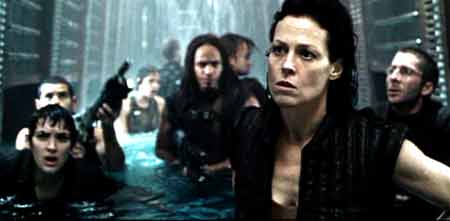Alien Resurrection had a lot going for it—released five years after Alien3, which received mixed reviews and garnered a fair amount of criticism for the decision to kill off several major characters, the fourth installment was an opportunity to give the franchise a fresh start. With Sigourney Weaver uninterested in resuming her role as Ellen Ripley, Fox brought in an up-and-coming screenwriter named Joss Whedon to craft a story around a cloned version of Newt, the traumatized young colonist introduced in Aliens. By all accounts, Whedon’s initial treatment was fantastic, but of course, we’ll never know how it would’ve turned out. When we started planning these rewatches, I wanted to revisit Alien Resurrection—I had a vague memory of the film being weird and messy, but maybe I hadn’t given it enough credit at the time. Even if it was a failure, given all the talented people involved, it would have to be an interesting failure, right? Sometimes an ambitious fiasco can be more interesting than a conventionally successful blockbuster theoretically, at least.
Then again, with some movies, all you can do is roll out the crime scene tape and try to figure out what went wrong and in this case, I’d argue that all the talent involved might be the movie’s biggest problem, since nobody seems to be on the same page: conversations and relationships seem stilted and bizarre, there seem to be big, weighty themes floating about waiting to bonk us on the head, but they never connect or come into focus.
As it turns out, Ripley’s there, after all. Sigourney was lured back to the franchise, intrigued by the script’s new take on the character and the chance to play an updated version of Ripley as part human, part alien. She’s supported by a cast of stellar character actors, including Ron Perlman, Michael Wincott, Brad Dourif and Dan Hedaya, all of whom I’ve enjoyed in many, many other movies, and all of whom seem completely wasted here.
Weaver also shares the screen with a secondary female lead, Call, played by Winona Ryder. While this casting might make even less sense in retrospect than it did at the time, I will say that in 1997, Winona Ryder could still do no wrong, in my book—I’d grown up watching her in Beetlejuice, Heathers, Edward Scissorhands—Winona was still a quirky indie superstar at this point in her career, and if she wanted to break into action movies, what better choice than in an already successful franchise with an actress that she idolized?
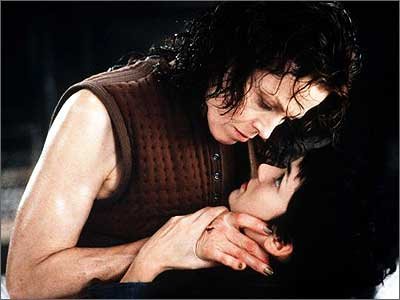
Similarly, the director at the helm seems like an unusual choice, but at the time, I was unbelievably excited about the prospect of Jean-Pierre Jeunet making strange with action movie conventions (and a blockbuster budget). The sheer weirdness of Delicatessen (1991) and The City of Lost Children (1995) had played a huge part in my burgeoning interest in indie film, as a kid—his movies were so dark and bizarrely beautiful, and so French. Sigourney Weaver used her clout to bring Jeunet on as a director, although just about every hot young director in Hollywood was considered for the job, including Danny Boyle, Bryan Singer, Paul W.S. Anderson, and Peter Jackson—and in spite of the fact that Jeunet didn’t speak English; he directed the movie through an on-set translator. (This last fact doesn’t seem surprising at all, if you’ve seen the film).
While these basic ingredients—screenwriter, script, stars, supporting cast, director—are all interesting and potentially positive on their own, however, in combination, they somehow curdle like heavy cream mixed with battery acid. The movie begins with the opening credits as the camera pans over a confusing mass of embryonic tissue and malformed features, which are revealed later to belong to the failed attempts to clone Ellen Ripley—genetic mutations kept in jars aboard the USM Auriga, 200 years after Ripley’s death.
Having successfully cloned Ripley (after seven previous attempts), military scientists extract the embryo of an Alien queen from her body—their aim is to raise the queen and use its eggs to breed more Aliens for some nefarious military purpose, and Ripley is left alive for further study, mostly as an afterthought. As Dan Hedaya’s character, the short-lived General Perez, blusters, “As far as I’m concerned, Number 8 is a meat by-product!”
Following surgery, Ripley/Clone #8 spends three days wrapped in some kind of weird futuristic cheesecloth cocoon, or possibly just performing terrible Matthew Barney-inspired performance art, eventually squirming her way free. If you’re not comfortable being repeatedly hit over the head with heavy-handed birth imagery, this scene should serve as a warning to run for the hills, because it only gets more ridiculous from here.The newly reborn Ripley has a few surprises up her sleeveless combat vest: she somehow retains the memories of the original Ellen Ripley, AND she’s swapped some DNA with the Alien queen that had been living inside of her, so now she’s got acid blood and is even more of a badass. If you want coherent scientific explanations for any of this, by the way, there are plenty of theories online, but the actual science in the movie is basically limited to Brad Dourif muttering creepily to himself and occasionally screaming stuff like, “You are a beautiful, beautiful butterfly!” to the Alien while covered in slime. It doesn’t make a whole lot of sense, but it’s fun to watch Weaver channeling the Alien—her dead-eyed stare and predatory, swaying movements.
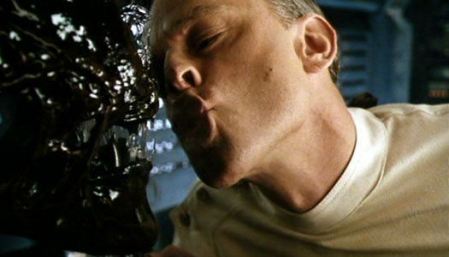
Meanwhile, the Betty, a ship carrying mercenaries and human cargo (to serve as hosts for the alien facehuggers), docks with the Auriga. The crew, including the menacing Johner (Perlman) and Call (Ryder) show up, meet Ripley and play a little space-basketball just in time for everything to go to hell thanks to the Aliens onboard escaping (surprise!) and going on a trademark Alien rampage.
The rest of the movie involves the crew of the Betty, a military scientist named Wren, one of the Alien hosts, and a single surviving soldier, following Ripley through the Alien-infested ship and getting picked off, one by one. Along the way, Ripley finds the seven previous monstrous versions of herself, cloned from the same DNA—it’s actually an affecting and horrifying scene, as the most human (but still incredibly grotesque) Ripley/Alien hybrid begs for death. Ripley obliges, tearfully toting a flamethrower, then continues on.
There’s an underwater Alien chase scene—for all those people who liked the previous Alien movies, but wished they could be more like The Poseidon Adventure, I guess? Oh, and it turns out that Wynona is a robot (cue Ripley: “I should have known. No human being is that humane.”). At the beginning of the third act, the Alien queen gives birth to a human/Alien hybrid—thanks to that super-scientifically feasible DNA swap with Ripley, somehow the queen ended up with a womb, and no longer needs eggs and human hosts to reproduce. Alien-in-labor isn’t exactly my favorite scene—so much slime, and goo, and like, gooey dangling slime-sacks—but if you’ve ever wondered what What To Expect When You’re Expecting would have been like as a David Cronenberg movie, well: you’re in luck.
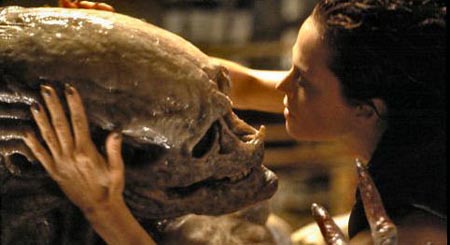 Unfortunately for the queen, the newborn bites her head off and bonds with Ripley, instead, following her back to the Betty as the survivors blast off toward Earth. Which brings us to the most disturbing scene in the movie, in which Ripley lures the hulking newborn hybrid away from Call and cuddles with it, while surreptitiously using her acid-blood to burn a hole through a nearby viewpane. As Call and Ripley cling to safety, the newborn is thrown against the hole, and the vacuum created rips its flesh apart, sucking it out into space, as Ripley watches and sobs.
Unfortunately for the queen, the newborn bites her head off and bonds with Ripley, instead, following her back to the Betty as the survivors blast off toward Earth. Which brings us to the most disturbing scene in the movie, in which Ripley lures the hulking newborn hybrid away from Call and cuddles with it, while surreptitiously using her acid-blood to burn a hole through a nearby viewpane. As Call and Ripley cling to safety, the newborn is thrown against the hole, and the vacuum created rips its flesh apart, sucking it out into space, as Ripley watches and sobs.
It’s one of those scenes that should be better than it is. There are so many thematic and visual references to motherhood, birth, identity, what it means to be human in the movie: is Ripley a “she” or an “it”? A person, a mere clone, a monster? What about Call, the most “humane” character, capable of free will, but not actually human? What about the earlier Ripley clones, and the newborn, which clearly identified with its human “mother”? Instead of engaging with any of these questions, the climax of the movie is simply brutal, and its attempted emotional payoff seems unearned—Ripley seems to feel some sort of bond with the creature being ripped apart before her eyes, but in the end, all the violence and drama rings hollow, since any semblance of meaning remains trapped in dense, heavy-handed metaphors and underdeveloped plot points.
Maybe this is just what happens when basic elements just don’t mix well: as much as you might love sushi and foie gras and crème brulee, cram them all together in a blender and you end up with something that looks like the crud they rinse out from under the Tilt-a-Whirl every night. Alien Resurrection is that nightmarish chunky carnival slurry: all the script revisions, the direction changes, the rejected endings, the competing (or at least never fully incorporated) visions of screenwriter, director, star, and studio leads the whole production to seem as unfinished, lumpy, and bizarre as Ripley Clones 1 through 7.
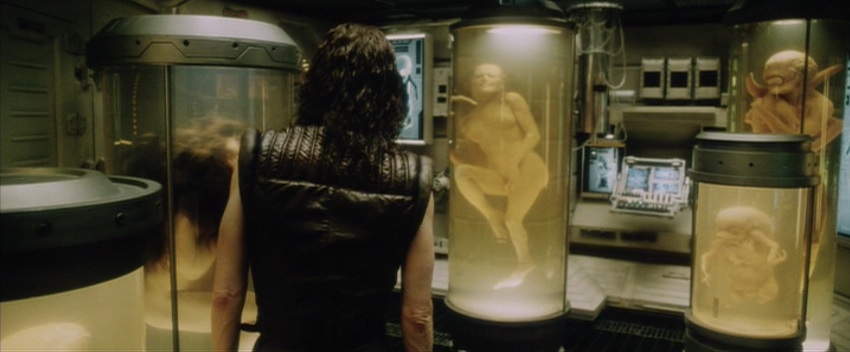
A large part of the blame rests on Jeunet, in my opinion—he envisioned the movie as a dark comedy, but what worked well in his earlier films fails rather hideously here. This includes his reliance on impish Frenchman Dominique Pinon, who has appeared in all of Jeunet’s films and can be effective and charming in the right roles—but in this particular film, his barely comprehensible French accent and ill-conceived performance as the foul-mouthed comic relief/loveable mascot of the Betty is hard to watch without hurling things at the screen. It is maddening.
And then there’s the dialogue: Whedon dialogue is its own animal—anyone familiar with the character of Dawn Summers in the Buffy series knows how painful a Whedon-penned sentence can sound in the mouth of a bad/miscast actor. It’s not always matter of how talented the actor is, though—nobody wants to see Lawrence Olivier deliver Billy Wilder dialogue; Orson Welles might not fit with Woody Allen. And there’s the matter of direction—many writer-directors from Quentin Tarantino and the Coen Brothers to Allen, Wilder, Welles, and Whedon work best when they can direct their own scripts, or at least pair off like-minded creative partners. As Whedon himself has noted, in the case of Alien Resurrection: “It wasn’t a question of doing everything differently, although they changed the ending; it was mostly a matter of doing everything wrong. They said the lines…mostly…but they said them all wrong. And they cast it wrong. And they designed it wrong. And they scored it wrong. They did everything wrong that they could possibly do.”
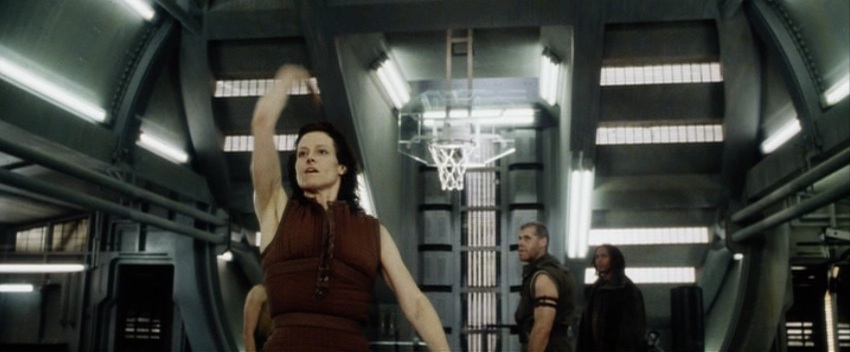
Then again, we can’t feel too badly for Joss Whedon, or anyone else involved: he not only directed the biggest movie of this summer so far, but he went on to make Firefly (a series which clearly shares some of its DNA with the Betty and its ragtag crew, although I’ve always found it funny that it includes not a single alien ). Jean-Pierre Jeunet followed up Alien Resurrection with Amelie (a critical and box office success, although I personally cannot stand it) and the much more interesting A Very Long Engagement. Sigourney Weaver got paid 11 million dollars to star in Alien Resurrection, and continues to be Sigourney F-ing Weaver (plus, the last thing I saw her in was the cameo in The Cabin in the Woods, so chalk up another one for the Whedonverse). Ron Perlman persists in his essential awesomeness, and Winona well, she was Spock’s mom, and she was crazy in Black Swan, so clearly she still loves the genre flicks (and is probably not really a robot). And of course, the Alien went on to collaborate with The Predator, so more on that later as the Countdown to Prometheus rolls on
Bridget McGovern is the non-fiction editor of Tor.com, and would love to play basketball with Sigourney Weaver and Ron Perlman some day. If you can make that happen, let her know via Twitter.










